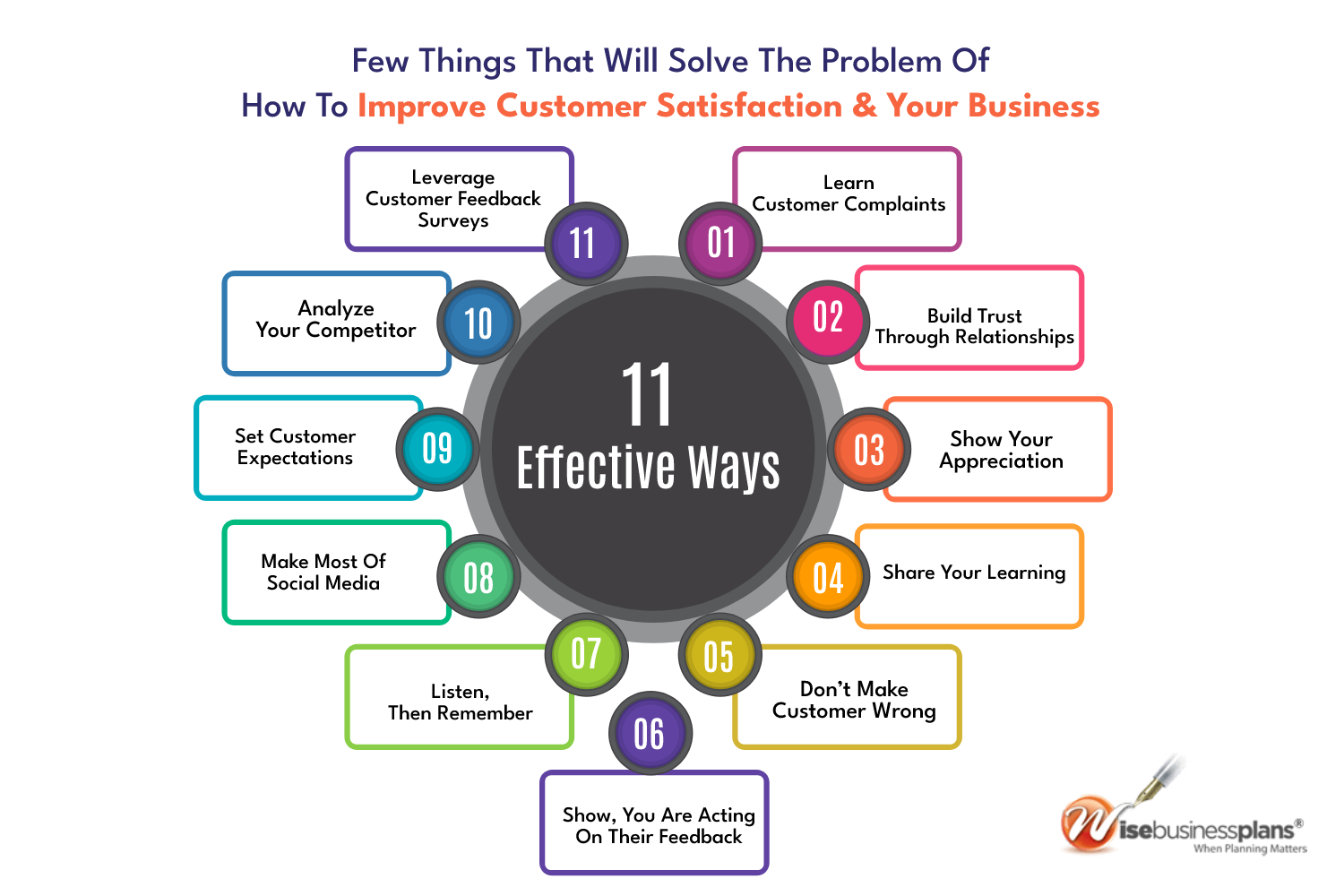How to Build Customer Loyalty
Do your customers use your products or services because they have to? Maybe you are the only game in town, or the most convenient. Or do they come to you because they honestly like you and your company? Do they buy from you out of loyalty to you and your brand?
- How to Improve Customer Satisfaction?
- 1. Learn From the Customer Complaints
- 2. Build Trust Through Relationships
- 3. Show Your Appreciation
- 4. Share Your Learning
- 5. Don’t make the customer wrong
- 6. Show, You Are Acting On Their Feedback
- 7. Listen, Then Remember
- 8. Make the most of social media
- 9. Set customer expectations
- 10. Analyze Your Competitor
- 11. Leverage customer feedback surveys
- FAQs:
How to Improve Customer Satisfaction?

With customers relying more and more on social media to spread the word about any companies that they love, (or hate), getting one customer to love you can quickly translate into hundreds or thousands. But, having one customer hate you can really cause problems, also.
So how can you get customers to love your business? Like most good things, in order to succeed, the relationship with your client should focus on giving, not getting.
Here are a few things that will solve the problem of how to improve customer satisfaction and your business can commit to, earning your customer’s loyalty and trust.
1. Learn From the Customer Complaints
 Due to online review sites, customer service is not a private matter anymore. Since a complaint posted on a website can quickly erupt into a public affair, However, a good response to customer dissatisfaction might ensure that you never receive that particular complaint again, and might even improve your brand reputation.
Due to online review sites, customer service is not a private matter anymore. Since a complaint posted on a website can quickly erupt into a public affair, However, a good response to customer dissatisfaction might ensure that you never receive that particular complaint again, and might even improve your brand reputation.
It’s important that your customer service team knows how to properly deal with these situations in a helpful and effective way.
Remember, receiving a complaint is not the end of the world. In fact, it can provide valuable feedback on how you can improve your business.
2. Build Trust Through Relationships
Your customers want a company they can rely on. Lasting relationships are built on trust, and that’s true for business relationships as well. Customers want to know they can rely on your products to last or to solve their problems, they are waiting for you to make good on your promises. Earn your customer’s trust and never break it.
3. Show Your Appreciation
Caring and appreciation can build a lasting relationship. Appreciation begins when a customer first comes into contact with your business, it’s how you answer the phone, how quickly you reply to emails, or the smile on your employee’s faces. Appreciation continues after you make the sale. Asking how the purchase worked out through a friendly letter or email can go a long way to building a loyal following.
4. Share Your Learning
Share a personal part of your business with your clients and customers. A sense of humor in your marketing materials, a story about your business experiences getting started, or simply a friendly chat when customers come in can give your business the human touch and give you an advantage over the corporate giants.
 5. Don’t make the customer wrong
5. Don’t make the customer wrong
Even if you don’t think you or your company have done anything wrong, make sure you apologize for any sort of inconvenience. Apologizing shows that you sympathize with the customer and that you’re acknowledging their feelings.
In customer service, an apology goes a long way. Also, when dealing with an unhappy customer, skip the sales pitch. Focus on customer service first in order to make sure your customer is satisfied enough to do business with you again in the future.
6. Show, You Are Acting On Their Feedback
Do your best to listen to any customer or client complaint, and when they understand that you are truly listening, even the most irate person will eventually calm down. Sometimes people just need to know they’ve been heard.
This is also a great opportunity to improve upon potential problems in your company. Listen to what your unhappy customer is saying with an open mind, and if a real issue exists, see how you can make sure the same problem doesn’t happen in the future.
7. Listen, Then Remember
Train your employees to write down any compliments and complaints, no matter how small. This way you will be able to look back at a history of issues and comments for trends or new problems that may have just popped up.
8. Make the most of social media
Staying in touch with your customers through emails, blogs, and other social media can also be an important factor. Letting your clients know about a problem you are having can head off a lot of irate calls and emails.
9. Set customer expectations
Many customers have developed expectations of their favorite businesses, and if your company isn’t living up to them, you could be hurting your reputation, your brand, and your sales. You have to understand why is it important to manage customer expectations or exceed customer expectations. Expectations aren’t only based on what you deliver, they’re based on what your competition can deliver, too.
Think like your customer. Put yourself in the customer’s shoes. When you buy products or services, what do you expect? Learn from unpleasant experiences when your own expectations aren’t met, and make sure the same type of thing isn’t happening at your company.
10. Analyze Your Competitor
Watch your competitors even closer. What are other businesses in your industry doing? If you sell burgers and everyone else is guaranteeing a half-pound of meat, that becomes the customer expectation and you’d better get with it. Are they open on the weekends? And kids eat free? You get the idea.
 11. Leverage customer feedback surveys
11. Leverage customer feedback surveys
Don’t be afraid to use surveys, both written and online, to find out how your customers feel. Develop systems to regularly gather feedback during and after the sales process, whether that’s comment cards at checkout or when your restaurant check is delivered, or survey forms delivered with invoices.
Our free invoice template collection has hundreds of invoice templates that you can use to create your invoices from scratch.
Pricing can also play an important role in retaining customers. Determine the right selling price with this easy-to-use profit margin calculator, to save money and increase customer satisfaction.
FAQs:
Effective strategies for building customer loyalty include providing exceptional customer service, offering personalized experiences, implementing loyalty programs, maintaining consistent communication, soliciting and responding to customer feedback, and consistently delivering high-quality products or services.
Loyalty programs are structured initiatives that reward customers for their repeat business and loyalty. These programs can include point systems, discounts, exclusive perks, or special promotions. Loyalty programs incentivize customers to continue choosing your business over competitors.
Providing exceptional customer service involves training and empowering your employees to go above and beyond to meet customer needs. It includes timely and effective communication, resolving issues promptly, being attentive, and showing genuine care and appreciation for customers.
Soliciting and responding to customer feedback shows that you value their opinions and are committed to improving their experience. Actively seek feedback through surveys, reviews, or social media, and use the insights gained to make necessary adjustments and address any concerns raised.
Yes, partnerships and collaborations with complementary businesses can expand your customer base and enhance loyalty. By offering joint promotions, cross-referrals, or co-branded experiences, you can provide added value to customers and tap into new markets.












